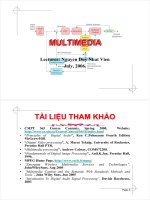Tài liệu Tư liệu tham khảo Di truyền y học
Bạn đang xem bản rút gọn của tài liệu. Xem và tải ngay bản đầy đủ của tài liệu tại đây (2.41 MB, 33 trang )
BÀI 12
DI TRUYỀN Y HỌC
( DÒNG DÕI VỚI NHỮNG KHIẾM KHUYẾT ? )
Cellular Basis of Cancer
Tế bào cơ bản gây ung thư
What causes Cancer?
Nguyên nhân gây ung thư là gì?
( Có thể do chất hóa học,vius hoặc vi khuẩn,có thể do bức xạ)
Hanahan and Weinberg, Cell 100: 57, 2000
Apoptosi
s
Oncogene
s
Tumor Suppressor
Inv. and Mets
Angiogenesis
Cell cycle
Một
số con
đường
gây
ung
thư
CANCER AND GENETICS
UNG THƯ VÀ DI TRUYỀN
•
Cancer: genome disease( Ung thư: Bệnh do gen)
•
Causes of genomic changes(Nguyên nhân của gen thay đổi)
•
Effects of genomic changes( Tác động của thay đổi gen)
Chromosomal changes in the genome of cancer cells: tip of the iceberg
(NST thay đổi trong bộ gen của tế bào ung thư: xuất phát tiềm ẩn lớn)
Terminal
Deletion
/>Ring
Chromosome
Robertsonian
Translocation
Deletion
Reciprocal
translocation
IsochromosomesInsertion Inversion
Duplication
Tế bào hình lưỡi liềm
Polymers of hemoglobin
deform red blood cells
Normal
Sickle
NORMAL ABNORMAL
Named after
this cutting
tool… a
sickle.
Tế bào hồng cầu thường
Tế bào hồng cầu hình lưỡi liềm
Tế bào ung thư
Tế bào ung thư
Tạo giao tử của cá thể XX
c. XYY individuals are male, and
tend to be taller than average.
Fertility is sometimes affected.
d. XXX individuals are usually
normal women, although they may
be slightly less fertile and a few
have below average intelligence.
e. Higher numbers of X and/or Y
chromosomes are sometimes
found, including XXXY,
XXXXY, and XXYY. The effects
are similar to Klinefelter
syndrome. Consequences of sex
chromosome aneuploidy in
humans are summarized in Table
11.2.
Biểu hiện của người có NST giới tính
không bình thường









